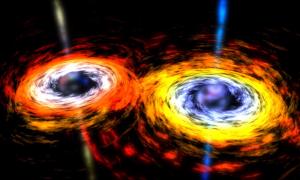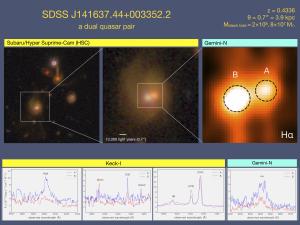Blog
Quasar for Two
3 September 2020
 NASA
NASAQuasars are some of the most powerful objects in the Universe. They were first discovered in the 1950s as bright radio sources coming from almost point-like objects. They were given the name quasi-stellar radio sources, or quasars for short. We now know that they are powered by supermassive black holes at the center of distant galaxies.
It is not the black holes themselves that emit so much light, but rather the superheated material surrounding the black hole. As the material is pulled ever closer to the black hole, it is squeezed and heated tremendously, which causes it to emit light across the electromagnetic spectrum.
A single supermassive black hole powers most quasars, which makes sense, because binary black holes tend to sweep material from their common region. Without closely surrounding material, a binary system isn’t likely to become a quasar. At least that’s what astronomers generally thought.
But as astronomers developed sophisticated computer simulations of accreting black holes, they found there were cases where two close-orbiting supermassive black holes could form a common accretion disk that could power a quasar. We’ve long known that merging galaxies can cause their black holes to form close binaries, so there should be binary black hole quasars.
Proving this isn’t easy. While computer simulations show they should exist, they would still be rare. Finding one takes not only high-resolution imaging but the ability to analyze thousands of binary quasar candidates. Recently a team successfully found one.1
 Silverman, et al
Silverman, et alUsing the Hyper Suprime-Cam (HSC) camera on the Suburu telescope, they looked at nearly 35,000 known quasars from the Sloan Digital Sky Survey (SDSS). After combing through the data, they found just 421 potential binaries. They captured HSC images of each of them, locating one strong candidate. They also imaged this galaxy with the Gemini telescope, confirming it as a binary system. One of the black holes has a mass of about 80 million Suns, while the other is about 200 million solar masses.
Based on this survey, the team estimates that binary black holes power only about 0.3% of quasars. But despite their small numbers, such quasars could provide a deeper understanding of how galaxies evolved in the Universe and the role black holes played.
Silverman, John D., et al. “Dual supermassive black holes at close separation revealed by the Hyper Suprime-Cam Subaru Strategic Program.” The Astrophysical Journal 899.2 (2020): 154. ↩︎